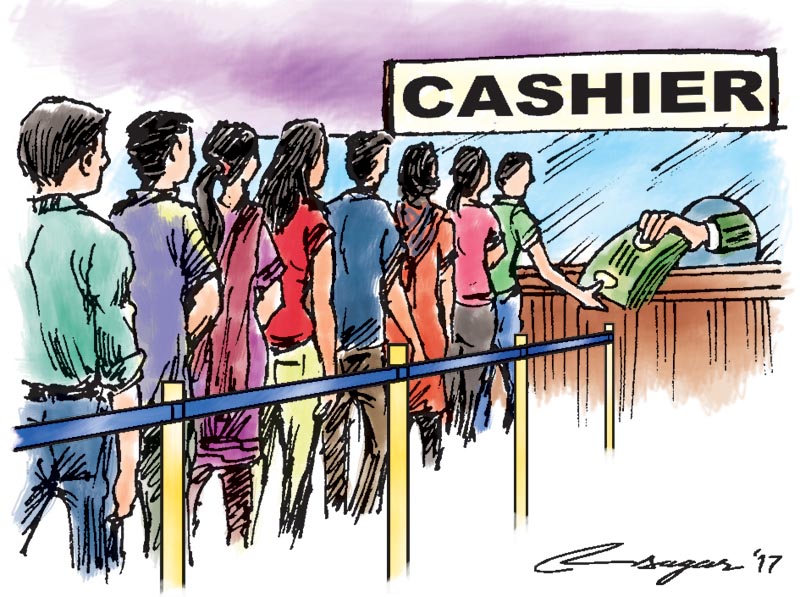Recent credit crunch: Who is responsible?
The increased interest rate should not be a serious problem. Borrowers enjoyed very cheap funds for long-term loans. Now it is the turn of depositors to get higher return
Robert Frost, one of the most admired American poets, comments on banking crisis saying that “a bank is a place where they lend you an umbrella in fair weather and ask for it back when it begins to rain”. So is happening in the Nepalese banking system more recently. The Nepalese financial institutions are suffering from a so called ‘credit crunch’. Most of the banks which stopped lending since January 2017 are still in the same position.
Theoretically, credit crunch is a situation in which banking system is unwilling or unable to lend to the prospective borrowers due to the severe loss in the previous lending or perception of higher risks in the newly provided one. It is thus either a situation emerged from the lax lending practices of the bank that they witnessed bad loans or the economic downturns such that banks observe negative return at their new lending. Nonetheless, Nepal’s case is not both of them.
The Global Financial Crisis of 2008 originated from a credit crunch in the US housing market. In July 2007, banks stopped financing subprime mortgages. The collapse of Lehman Brothers and the aftermath of the credit crisis ultimately led to a global financial crisis, bringing into a turning point understanding on banking regulations. Although the country of crisis origination, the USA, is now said to be out of the crisis “theoretically”, many European and Asian economies are still struggling to bounce back.
Nepal’s financial sector is premature compared to the world markets. The financial liberalization process was initiated with the Economic Stabilization Program of the IMF and Structural Adjustment Program of the World Bank in 1985. At that time, strengthening government banks, allowing private sectors in banking business, opening up business for private and facilitation of international trade were the major agendas of the reform.
After the restoration of democracy in 1990, post-democracy governments remained liberal in the role of private sectors. Financial liberalization programs were introduced in the presence, products, costs and returns of the banks.
As a result, financial institutions and their branches surged rapidly, new financial products came into practice and financial deepening indicators topped even India. However, these did not enhance the overall development of the financial sector. The institutional capacity remained poor with weak efficiency and effectiveness.
During the early 2000s, the country launched a second-stage reform and some programs are still going on. Recently, financial sector development strategy (FSDS), a comprehensive and planned development effort, has been adopted for five years from now.
Generally, in a liberalized financial market, financial institutions are free in choosing the product, cost, strategy and customers but within the closely regulated environment. As the financial sector is very sensitive to economic stability, prudent regulatory and supervisory measures are enforced to maintain financial stability.
Despite the regulations and warnings of the upcoming financial typhoon, the recent case of the so called ‘credit crunch’ or ‘liquidity crunch’ seems to have originated from the side of providers, not regulators or other macro players, such as the government.
First, the proximate cause of the credit crunch was the asset-liability mismatch of banks. As their deposit was growing at about 20 percent, credit grew as high as 32 percent. Second, banks in general should lend for short-term by using money market instruments. However, Nepalese private sectors prefer bank lending even for longer-term financing, rather than issuing shares or corporate bonds through capital markets. This has led to a structural problem of liquidity mismatch- short term deposit for long-term financing. Third, regarding the remittance slowdown, it was gradually declining since the mid-2015.
It is often heard that banks blame the government for poor capital spending. However, it was their ill preparedness to perceive that government spending would do well this year. The symptoms were observed at the first quarter but the banking system ignored it. Expectations of radical change in government bureaucracy were a false projection. Likewise, through the monetary policy, the central bank had warned banks that there is an upside risk of real estate and asset price bubbles. The policy had suggested reorienting the bank lending towards productive sectors. Some policy measures such as lowering down the loan-to-value ratio, enforcing margin lending limits, were signals to the market. Banks should have learnt it as a credit stance of the central bank, but no one realized this.
Thus, although it would not be fair to say that there was no role of the central bank and government in the recent financial friction so far, the major cause of the credit crisis was a premeditated plan to have higher profit targets to meet the regulatory capital requirements. By default, higher capital requirement increases the cost of fund in one hand and squeezes the profit on the other. This should have been understood clearly by the concerned stakeholders. The increased interest rate should not be a serious problem. Because borrowers enjoyed very cheap funds for longer period now is the turn of depositors to get higher return. Still, Nepal’s interest rate is even lower than that of India.
Bhatta is associated with Nepal Rastra Bank






